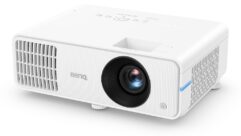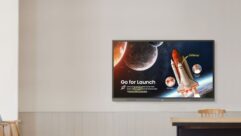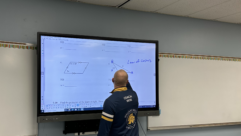
Higher Education
Sep 1, 2007 12:00 PM,
By Dan Daley
Media academies gear up to educate the next generation of systems specialists.

Students enrolled in Full Sail Real World Education’s Show Production and Touring associate’s degree program get hands-on training with a Digico D5 digital audio console.
Back in high school, it might have been more fun to have been the guitar player than the AV specialist. However, at a time when the music business has hit the skids, while home theaters and connected building projects are booming, media academies that once predicated their curricula on music recording have turned their attention to the systems installation and integration market. They want to become the resource for the next generation of systems specialists, and their timing seems to be perfect.
The 2007 Market Definition & Strategy Study released by InfoComm International in June 2007 shows the overall systems industry was worth $25 billion in 2006, up from $18.9 billion three years ago, and it is growing at about 12 percent a year. Most telling, though, according to InfoComm Executive Director Randal Lemke, is that the biggest share of that growth comes from installation and integration services, rather than products.
“That really underscores the need for more training to relieve what is a chronic shortage of trained technicians,” Lemke says.

Scott Kieklak, an instructor for the SAE Institute’s Systems Integration course, shows students a basic wiring setup for a small audio system using a Mackie 1604 mixer, a compressor, an effects processor, and powered monitors.
AT SCHOOL
Chris Davie, director of the SAE Institute’s new Atlanta school, which opened in August, says the new facility reflects the new realities of the business of audio and other media technology. It will have an advanced server-based system that allows students to access their work projects from any room in the facility. As useful as that will be (it’s also a feature at SAE’s four other U.S. locations) for students learning the ins and outs of record making, it’s also a trope for what Davie predicts will be a continuing trend in which students begin to recognize systems integration as a primary career path.
“I think just using the server system itself stimulates some students onto thinking about other possibilities,” says Davie, who once worked in the systems installation field himself. “The fundamentals of signal flow are the same for music and for installation, and we try to make the connection with systems integration when we do field trips to clubs, radio stations, and broadcast facilities.”
At Full Sail Real World Education’s main campus near Orlando, Fla., an installation/integration academic track has been in place since 2004 in response, says course director Dale Rock, to a widening gap between demand for residential and commercial systems design and integration and the limited pool of experienced people who can design, install, and maintain them.
“There’s definitely a shortage of well-trained and knowledgeable installers and integrators, based on what the installation companies are telling us,” says Rock, who owned his own installation firm in central Florida for six years before starting the Installation Technologies course at Full Sail in 2004. “We had also been hearing, through our placement department, about a number of our students that had graduated and were working at touring lighting and sound companies that also have full-time installation divisions doing installs when not on tour. Those are things that started us thinking about creating a formal course on the topic.”
The Installation Technologies course at Full Sail is part of the school’s Show Production and Touring associate’s degree program, which costs students $45,005. The course is composed of 68 hours, split between class and lab work. The final exam consists of successfully completing a small LAN wiring layout, programming an AMX touchpanel controller, and doing a small 70V installation. The final accounts for 50 percent of a student’s final grade.“If they get one pin wrong on the LAN, they lose 10 percent of their grade right there,” Rock says. “I did that deliberately because this is an industry in which there is a lot of pressure to get it right the first time.”
Full Sail has also pursued alliances with installation companies, just as it has with music recording technologies. Relationships are in place with JBL, Lexicon, Krell, and BSS, among others. The school also has its own home theater and home automation labs.
“We currently use an AMX NI2000 in our home theater and automation labs, and plan to upgrade with a new Crestron system this coming year,” Rock says.
Where Full Sail’s installation course grew out of the synergies of its live sound and touring curriculum, Chris Davie says SAE’s Systems Integration course, part of a larger associate’s degree track costing students $21,700, owes much to the school’s emphasis on technical facility design. The course accounts for 20 class and lab hours out of the school’s nine-month course of study, and it covers low-voltage design and installation, programming, and system networking, among other topics. Students are paired off in teams and must choose an integration project, research all of its components, draw up an installation strategy, and plan and submit it as a paper, often using CAD renderings and schematics.
The media academies seem to be a natural fit for training entry-level technicians. The degree tracks in place teach fundamentals such as signal path and elementary electronics as part of their base curricula, skills that form the foundation of installation and integration work. Audio, video, and multimedia are key entertainment technologies that are also increasingly part of the home and commercial environments. Programming, whether it’s a synthesizer or a Crestron touchscreen, is another common requirement.
“The installation course bridges the gap between the basics and the core material of our show production division,” Rock says. “One Show Production class will teach things like windings, amplifier operation, constant voltage, and so on, and the other will get into things like calibration, TEF, and Smaart analysis. I’ll add the mechanics of installation and integration to that. My course alone would produce a knowledgeable, entry-level helper. Combined with the education you get from the rest of the courses, it produces someone who moves up the ladder very quickly into positions of systems designer, lead installer, and programmer.”
ORGANIZATIONAL RESPONSE
Three of the main industry trade organizations, InfoComm International, CEDIA, and NSCA, run ongoing training programs, but they have also placed new emphasis on basic training and recruitment initiatives in recent years. Last March, InfoComm launched its CareerCorps program in Washington, D.C., a two-weekend pilot program that introduces neophytes to the basics of systems technology, culminating in job interviews with systems integration companies, who pay a hiring fee. InfoComm has also beefed up other basic training initiatives, including its online offerings and its global three-day CTS Prep program. It is licensing its core curriculum, developed in collaboration with the organization’s constituency, to seven colleges thus far nationally.
“This is definitely the moment to begin fostering things that can expand the workforce,” Lemke says.
Earlier this year, CEDIA partnered with the Consumer Electronics Association (CEA) and NSCA to create the Electronics System Professional Alliance (ESPA), an initiative to develop a basic core curriculum for residential systems technology to address what CEDIA Executive Director Don Gilpin calls a serious shortage of skilled labor. “We’re seeing a greater demand for integrated systems in the home, but we’re not seeing a corresponding increase in young people coming into the industry as integrators,” he says.
CEDIA’s ongoing education efforts at its expos more than doubled attendance from 3,000 students in 1999 to 6,500 in 2006, but Gilpin acknowledges that more needs to be done. “ESPA will be a common curriculum across several organizations that will create a critical mass of entry-level people into the industry,” he says.
But media academies, with their technically oriented faculties in place, offer a systems training gateway to a cohort that can help swell the ranks of integrators. Lemke recalls an effort in 2001, using federal grant funds, to develop an installer curriculum at six community colleges around the United States.
“It was not a great success,” he says. “The colleges could teach electronics, but they simply didn’t have the systems-specific expertise on their faculty.”
All the more reason to look to the entertainment technology colleges, Rock says, noting his background in integration and regular lectures by visiting installation experts such as Dan Lee, a sales engineer with Signature Systems of Florida.
Lemke says InfoComm has maintained a low-level dialog with several schools over the last several years, and it has funded several $1,200 to $1,500 scholarships to Full Sail in that time. “[Systems] training is just starting to evolve from an apprenticeship model to an academic one,” he says. “There’s a movement towards formal education that these technical schools really help with.”
Gilpin says CEDIA has not reached out to the technical academies, preferring to consolidate its own basic curriculum through ESPA first. “But any awareness that any school brings to this industry is a good thing,” he says.










